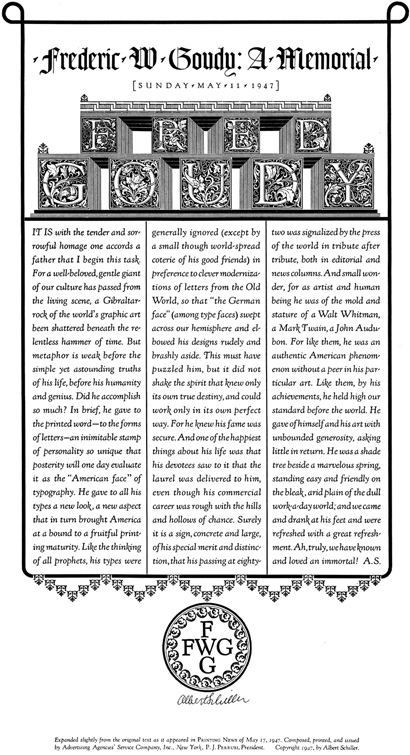One of my world wide web pleasures is Randombrowsing™ the American Memory section from the Library of Congress web site in “Gallery View” mode. Where else can you do a search for “bear” and in the first page of results get a typographic treat like this? Or “nails”? Or “speed”? Et cetera. Over the weekend, as I was looking for visual nuggets to illustrate the Copperplate Gothic post, I typed in “Frederic Goudy” and crossed my fingers. Only two results: one a dud, the other a gem. As my eyes focused on the grainy, low contrast image I began taking in the contents: The blackletter at the top, the gently letterspaced date set in small caps, the majestic initial caps, and, ultimately, the beautiful text set in a deliciously swashy, briefly-serifed italic typeface. All of these, of course, of Goudy’s own making — a true testament to the diversity of design that this typographer possessed. A memorial tribute to Frederick Goudy by Albert Schiller, this lucky image contains a prose as jovial as Goudy’s own designs. As a counterpoint to coldly-written obits, I thought it would be worth sharing this passage, hidden among 9 million other documents.

Library of Congress, Rare Book and Special Collections Division.
Image cleaned-up in Photoshop; bigger view in pop-up.
IT IS with the tender and sorrowful homage one accords a father that I begin this task. For a well-beloved, gentle giant of our culture has passed from the living scene, a Gibraltar-rock of the world’s graphic art been shattered beneath the relentless hammer of time. But metaphor is weak before the simple yet astounding truths of his life, before his humanity and genius. Did he accomplish so much? In brief, he gave to the printed word—to the forms of letters—an inimitable stamp of personality so unique that posterity will one day evaluate it as the “American face” of typography. He gave to all his types a new look, a new aspect that in turn brought America at a bound to a fruitful printing maturity. Like the thinking of all prophets, his types were generally ignored (except by a small though world-spread coterie of his good friends) in preference to clever modernizations of letters from the Old World, so that “the German face” (among type faces) swept across our hemisphere and elbowed his designs rudely and brashly aside. This must have puzzled him, but it did not shake the spirit that knew only its own true destiny, and could work only in its own perfect way. For he knew his fame was secure. And one of the happiest things about his life was that his devotees saw to it that the laurel was delivered to him, even though his commercial career was rough with the hills and hollows of chance. Surely it is a sign, concrete and large, of his special merit and distinction, that his passing at eighty-two was signalized by the press of the world in tribute after tribute, both in editorial and news columns. And small wonder, for as artist and human being he was of the mold and stature of a Walt Whitman, a Mark Twain, a John Audubon. For like them, he was an authentic American phenomenon without a peer in his particular art. Like them, by his achievements, he held high our standard before the world. He gave of himself and his art with unbounded generosity, asking little in return. He was a shade tree beside a marvelous spring, standing easy and friendly on the bleak, arid plain of the dull work-a-day world; and we came and drank at his feet and were refreshed with a great refreshment. Ah, truly, we have known and loved an immortal! A.S.






Type for breakfast! Deliciously aged, too. Great find, Armin.
On Sep.06.2007 at 08:29 AM